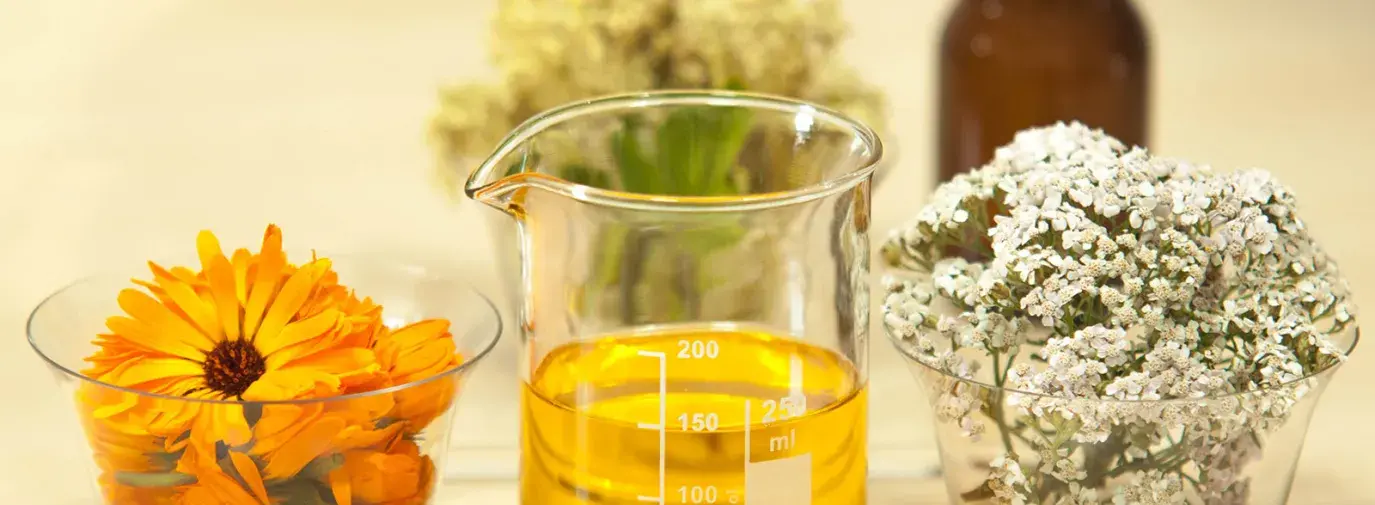
When we talk about herbs, it’s often in the context of tea or food. But the ways that herbs can support the body aren’t limited to what they do inside. The same plant chemicals that boost health after they’ve been ingested will also support the body from the outside.
Using herbs topically is easy and effective, and even safer than consuming them, because there’s no possibility of interference with medications.
Think of the body as a fortress. Diet, hydration, and stress levels affect the strength of the fortress to defend you from “invading” germs such as bacteria, viruses, and fungus. The first line of fortress defense is basic preventative health. Drink your water. Eat well, especially healthy fats. Get all your vitamins and minerals. These basic inputs keep everything in working order.
The skin, the largest organ of the body, is designed to keep invaders out of your fortress. If the fortress is “breached” by injury or trauma, herbs can help to repair it gently and effectively. They are an affordable, easy first aid.
Many topically healing herbs are easy to grow in gardens or containers, and others can be purchased in the tea section of most grocery stores. Some are common weeds!
Toxins and your Skin
Humans absorb much of what we put on our skin—and we put on a lot. US women use an average of 12 cosmetic products with 168 unique ingredients each day and men use 6 products with an average of 85 ingredients, according to the Environmental Working Group.
“These ingredients alone can add up to a phenomenal array of combined exposures to a variety of toxins,” says Janet Nudelman, director of program and policy at the Breast Cancer Fund.
Love your skin by caring for it with nontoxic, organic products and herbal remedies you make yourself or buy from deep-green businesses found in Green America’s National Green Pages®.
Types of Topical Healing Herbs
When we talk about herbs, we use “actions” to understand how different plants do what they do. Topical herbs fall into several categories of actions.
 An anti-microbial herb destroys invading microbes: bacteria, viruses, and fungus. Some herbs are anti-bacterial, some are anti-viral, some are anti-fungal. Some plants are a combination, and a few (such as garlic) are “broad-spectrum antimicrobials,” meaning they fight all three.
An anti-microbial herb destroys invading microbes: bacteria, viruses, and fungus. Some herbs are anti-bacterial, some are anti-viral, some are anti-fungal. Some plants are a combination, and a few (such as garlic) are “broad-spectrum antimicrobials,” meaning they fight all three.
 An anti-inflammatory herb calms excess inflammation. Inflammation consists of heat, redness, swelling, and pain. The process of inflammation is necessary to healing: it brings resources to the site of trauma. But sometimes, inflammation isn’t helpful, as in cases of allergic reactions or itchy bug bites; ongoing, chronic inflammation can be damaging to the tissue, not to mention uncomfortable for you.
An anti-inflammatory herb calms excess inflammation. Inflammation consists of heat, redness, swelling, and pain. The process of inflammation is necessary to healing: it brings resources to the site of trauma. But sometimes, inflammation isn’t helpful, as in cases of allergic reactions or itchy bug bites; ongoing, chronic inflammation can be damaging to the tissue, not to mention uncomfortable for you.
 A vulnerary herb supports healing of tissue. (How amazing is that?) The body has various immune cells that heal wounds, and herbs can help every step of the way. Vulneraries can support healing of wounds, scrapes, rashes, burns, sprains, torn muscles, broken bones, and even bruising. Vulneraries can work internally as well as externally, but here we’re focusing on external application.
A vulnerary herb supports healing of tissue. (How amazing is that?) The body has various immune cells that heal wounds, and herbs can help every step of the way. Vulneraries can support healing of wounds, scrapes, rashes, burns, sprains, torn muscles, broken bones, and even bruising. Vulneraries can work internally as well as externally, but here we’re focusing on external application.
How to Prepare Herbs to Use Topically
Depending on the plant, the immediacy of the need for healing, and how much of a project you’d like to take on, there are a number of ways to prepare your topical plant healing:
- Just use the fresh plant: pick some leaves and rub them on your skin.
- Spit poultice: chew up a leaf or two, spit it out, and apply it to the affected area. Great for bug bites, scrapes, scratches, and things that happen out in a field. Warning: this remedy is not always tasty. Actually, it is never tasty.
- Poultice: soak the plant in hot water for ten minutes or so, as you would to make a tea. Use 1-2 large handfuls of herbs in 1-2 cups of water. If you’re using fresh leaves, mash or chop them up, mojito style. Let the plant cool, and then apply it to the affected area. Wrap it up with a cloth and perhaps cover that with plastic wrap to contain the messiness. Apply 20 minutes at a time, several times per day. Great for sprains and injuries without broken skin.
- Compress: prepare just like a poultice (above). Strain out the plant matter and soak a cloth in the leftover brew. Apply that cloth to a scratch, wound, or sprain. This prevents plant matter from getting lodged in an open wound and is generally less messy.
- Oil, salve, or cream: more complicated to make yourself, but certainly doable if you’re interested. Oils, salves, and creams are ready when you need them and less messy to apply than compresses or poultices. They’re available from herbalists and organic markets; more common remedies can be found at grocery stores.
- Essential oil: a few plants are best applied as pure essential oils. These come in little brown jars and are found in herbal supply stores and organic markets. Many pounds of plant matter are distilled to separate just the volatile oils. They will last you a long time, however—only a drop or two is needed for a topical application. Warning: Most essential oils are too strong to apply directly to the skin; dilute with a little carrier oil (i.e. jojoba, olive, etc.) or use in a salve.
DIY herbal remedies
For recipes on how to make your own herbal salves, infusions, lotions, and more, consult the Mountain Rose Herbs blog. (Just search for the type of topical remedy you want.)
The wonderful thing about herbs is that they play well together. Rather than contraindicating each other, they create synergy, making the whole greater than the sum of its parts. Feel free to mix and match the healing plants that you have available. Enjoy your natural healing experiments!
Here’s a nice compress recipe for scrapes, scratches, or wounds:
Bike-Wreck Compress
1 part chamomile flowers
1 part calendula flowers
1 part yarrow leaf & flower
1 part comfrey leaf
1 part plantain leaf
Steep ¼ cup herbal mix in 2 cups water for 10-15 minutes or until it is comfortable to touch. Strain through a French press. Soak a cloth in the liquid and apply to scrapes, scratches, or wounds for 20 minutes. Repeat several times per day. Store liquid in the refrigerator for up to 1 day or overnight.
Top Ten Herbs for Your Topical First-Aid Kit
This list starts with plant products that are easiest to purchase, and moves toward plants that are easy to grow and harvest, if you’re of a gardening disposition. These are all fantastic to keep on hand in case of injury. Bulk herbs and tea bags should be replaced every year. Label everything, and store it in a cool, dark place—no windowsill storage!
It’s safe to use these as you would a lotion, applying whenever you need relief, unless otherwise indicated.
![arnica[1].jpg (275×150)](http://live-green-america-labs.pantheonsite.io/sites/default/files/2017-01/arnica%5B1%5D.jpg)
 1. Arnica flowers (Arnica Montana or Arnica chamissonis)
1. Arnica flowers (Arnica Montana or Arnica chamissonis)
Purchase gel, cream, or oil and apply to bruises and sore muscles.
Do not apply to broken skin. The plant is very acrid and shouldn’t be used internally (except homeopathically). The gel is more cooling than the cream. Arnica is mostly a mountain plant, but A. chamissonis grows easily in other climates.
![lavender[1].jpg (275×150)](http://live-green-america-labs.pantheonsite.io/sites/default/files/2017-01/lavender%5B1%5D.jpg)
 2. Lavender flowers (Lavandula angustifolia)
2. Lavender flowers (Lavandula angustifolia)
Purchase essential oil for burns.
Lavender is one of the few essential oils that is safe to apply directly to the skin, and it works well even for severe burns. The scent of lavender is also relaxing, so it’s nice to have around to sniff if life is stressful. Lavender is easy to grow if you plant a seedling, rather that seeds. Essential oil requires pounds of flowers and expensive machinery, so it’s much easier to buy a small bottle.
![st-john-wort[1].jpg (275×150)](http://live-green-america-labs.pantheonsite.io/sites/default/files/2017-01/st-john-wort%5B1%5D.jpg)
 3. John’s wort flowering tops (Hypericum perfoliatum)
3. John’s wort flowering tops (Hypericum perfoliatum)
Purchase oil or make an infused oil or salve for nerve pain and eczema.
St. John’s wort has many traditional uses and is one of the few herbs that’s been subjected to a lot of scientific research. The topical oil calms nerve pain such as sciatica, and skin conditions such as eczema; it may also relieve psoriasis. St. John’s Day is June 20, the day before Midsummer, and St. John’s wort is said to flower on that day. It is considered an invasive weed in the Pacific Northwest, so locals there might have good luck harvesting the flowering tops.
![chamomile[1].jpg (275×150)](http://live-green-america-labs.pantheonsite.io/sites/default/files/2017-01/chamomile%5B1%5D.jpg)

 4. Chamomile flowers (Matricaria recutita)
4. Chamomile flowers (Matricaria recutita)
Purchase teabags for inflammation and skin-healing.
German chamomile is anti-inflammatory and vulnerary, and so easy to turn into a compress when you purchase teabags. Of course it also makes a nice nervine tea (i.e. benefits the nervous system) to calm you down while you heal. If you’re feeling crafty, you can infuse the flowers in oil and make a salve or lotion. It’s very gentle, safe enough for babies with rashes or scrapes. Chamomile has also been studied clinically and has been shown to speed healing of tattoo abrasions.
Chamomile is a self-reseeding annual plant; you will need a fair amount of space for your plants to harvest enough flowers for your future compresses. Chamomile cream is also available for purchase.
![tobacco[1].jpg (275×150)](http://live-green-america-labs.pantheonsite.io/sites/default/files/2017-01/tobacco%5B1%5D.jpg)
 5. Tobacco leaf (Nicotiana tabacum)
5. Tobacco leaf (Nicotiana tabacum)
Make a spit poultice for bee stings. (It’s not tasty, but it is effective.)
Most of us don’t have access to pure tobacco leaves, which is a shame because they’re so useful for stings. Purchase a pack of natural cigarettes, and aim for a brand without too many chemicals.
![aloe[1].jpg (275×150)](http://live-green-america-labs.pantheonsite.io/sites/default/files/2017-01/aloe%5B1%5D.jpg)
 6. Aloe inner leaf (Aloe barbadensis)
6. Aloe inner leaf (Aloe barbadensis)
Use the fresh plant for burns.
Aloe is a succulent plant; when you snap off a leaf, the inside is a gel-like substance that is cooling and soothing to burns and dry skin.
Aloe is very, very easy to grow. Refrain from over-watering, give it some sunshine, and there you are; bring it inside for the winter if you live in a cold climate.
![yarrow[1].jpg (275×150)](http://live-green-america-labs.pantheonsite.io/sites/default/files/2017-01/yarrow%5B1%5D.jpg)

 7. Yarrow leaf and flower (Achillea millefolium)
7. Yarrow leaf and flower (Achillea millefolium)
Use fresh or dried as a compress or poultice; use fresh leaf for spit poultice on wounds, scrapes, and cuts.
Yarrow is an anciently revered herb, frequently grown as a decorative shrub. Yarrow is anti-bacterial, vulnerary, and, rather uniquely, a hemostat, meaning it helps stop bleeding. These qualities make it ideal for fresh wounds. Wash the wound first, preferably in salt water, and then soak in a yarrow infusion. For quick care in the middle of your garden, chew up some leaves (they’re bitter) and put them onto the wound.
The medicinal plant has white flowers. Other species may have some of the same properties, but aren’t guaranteed to be interchangeable.
![calendula[1].jpg (275×150)](http://live-green-america-labs.pantheonsite.io/sites/default/files/2017-01/calendula%5B1%5D.jpg)

 8. Calendula flowers (Calendula officinalis)
8. Calendula flowers (Calendula officinalis)
Use fresh or dried as a compress; oil, salve, cream for wounds, scrapes, and burns. Add a cup or more of flowers with some Epsom salts to your bath, and soak away your sunburn. Do not use on puncture wounds. Calendula is another anciently used herb. Creams and salves may be available for purchase, or make your own. The flowers are yellow or orange, and are high in resin—a sticky substance. When your fingers are a bit sticky after harvesting the flowers, you know you have good medicine. It’s an easy-to-grow annual.
![plantain[1].jpg (275×150)](http://live-green-america-labs.pantheonsite.io/sites/default/files/2017-01/plantain%5B1%5D.jpg)

 9. Plantain leaf (Plantago major or Plantago lanceolata)
9. Plantain leaf (Plantago major or Plantago lanceolata)
Use as a compress or poultice; oil, salve, cream for wounds, scrapes, and inflammation; use fresh leaf for spit poultice on bug bites.
Plantain is not the banana sort of plantain but a humble weed with healing magic! It is also called “white man’s footprint” because it followed European settlers to the New World. It is anti-inflammatory and vulnerary, wonderful when used as a poultice or compress, or infused in oil and made into a salve or cream. Out in the field, chew up a fresh leaf and apply to a bug bite to quell the itch. Plantain likes to grow by the sides of roads and through cracks in the sidewalk; it’s easy to harvest your own but make sure to do it in a clean location. The round leaf and the sharp leaf varieties are interchangeable.
![comfrey[2].jpg (275×150)](http://live-green-america-labs.pantheonsite.io/sites/default/files/2017-01/comfrey%5B2%5D.jpg)
 10. Comfrey leaf and/or root (Symphytum officinale)
10. Comfrey leaf and/or root (Symphytum officinale)
Use fresh or dried leaf as a compress or poultice; leaf or root for oil, salve, cream; use on cuts, scrapes, wounds, bruising, sprains, pulled muscles, broken bones. Do not use on puncture wounds.
Comfrey is also known as “knitbone” for its ability to heal not only skin but also bone and connective tissue. Comfrey is a wonderful vulnerary. A poultice, compress, or salve is very helpful for any sort of tear or pull or break of the body. It is so effective that it should never be used on puncture wounds, because it will heal up the top of the puncture so fast that the inside, deeper part of the wound doesn’t have time to keep up. Comfrey is easy to grow once it’s established and will grow up to four feet tall, yielding leaves all summer. The leaves are just as effective as the root. Lesser species have white flowers, but the true (and taller) comfrey has purple flowers.
—Tricia McCauley holds a Master’s degree in herbal medicine and is a Certified Nutrition Specialist, a Licensed Dietitian-Nutritionist, and a certified health coach and yoga teacher. Find her online at nutriciaconsulting.com
Resources
Choosing organic (or close-to-organic, “consciously wildcrafted”) herbs from responsible green companies helps you avoid toxic pesticide residues and support organic farming. The following companies are certified by Green America for their top-level green practices:







